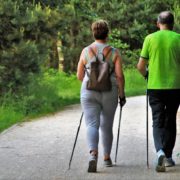Six Tips for Managing Knee Pain without Medication
When you’re suffering from lingering knee pain that just won’t go away, it can deeply affect your day-to-day life.
And when this happens – it’s easy to become desperate and resort to daily medication – or “quick fix” procedures or surgery. But there’s good news – there are plenty of natural, non-medicated ways to manage knee pain successfully and improve how you feel – even if you’ve been dealing with knee pain for years. You don’t always need medication or invasive treatments to find relief – despite what the medical community tells you.
Here are six effective tips to help you manage knee pain naturally:
1. Strengthen Your Hips and Core
Your hips and core play a crucial role in providing stability and support for your knees, as these muscles work together to ensure proper alignment of your entire lower body. When these muscle groups are weak or unbalanced, your knees bear the brunt of poor mechanics during movements like walking, running, and squatting. This leads to unnecessary strain, which can worsen knee pain over time. By strengthening your hips and core, you can improve your overall body mechanics, reduce stress on your knees, and promote long-term joint health. Over time, not only will this help alleviate current knee pain, but it will also significantly reduce the risk of recurrence. Incorporating exercises such as glute bridges, side leg lifts, and planks into your routine can make a noticeable difference in your strength and stability.
2. Improve your Flexibility
Mobility comes before stability when it comes to joint health. Stiff joints force surrounding muscles to overcompensate, which can lead to even more discomfort and inefficiency in movement. Improving your flexibility – particularly in the hips, hamstrings, and quadriceps – helps distribute forces evenly through your body and reduce strain on your knees. Regular stretching, yoga, and specific mobility exercises are great ways to maintain flexibility and keep your knee joints moving freely. A regular mobility practice is essential for reducing chronic knee pain and discomfort, preventing injuries, and enhancing overall athletic performance, balance, and coordination in your daily activities and exercise routines.
3. Don’t Sit too Long
Sitting for extended periods can cause stiffness in your knees and reduce circulation, which can lead to more pain. Additionally, knee pain might stem from your back or hips, even if you don’t feel pain there, and sitting for too long accentuates problems in these areas as well. By standing up and moving regularly throughout the day, you can prevent the muscles around your knees from tightening up and maintain better alignment. Simple actions like standing every 30 minutes, doing some light stretches, or walking around your space can make a big difference. Even if you don’t have knee pain right now – this is a good practice to get into – because it will go a long way in preventing it.
4. Stay Active
Regular, low-impact exercise is one of the best ways to manage knee pain naturally. Activities like swimming, cycling, and walking increase blood flow, which helps reduce inflammation and promotes joint lubrication. Movement also releases endorphins – your body’s natural pain relievers. If arthritis is a concern, consider activities that build strength without overloading the knee, like Pilates or resistance band exercises. Movement is key, but be sure to avoid high-impact exercises that could exacerbate your pain. Focus on activities that maintain flexibility, balance, and muscle endurance for overall joint support in your knee..
5. Wear Supportive Footwear
Footwear is often overlooked when it comes to knee pain, but wearing shoes that provide adequate support and cushioning can make a huge difference. Shoes that don’t support your feet properly can cause poor alignment, which translates to extra stress on your knees. Opt for shoes that prioritize comfort, good arch support, and alignment to help reduce the impact on your knees. If necessary, consider custom orthotics to improve foot and knee mechanics, as well as periodically replacing worn-out shoes to maintain optimal support and prevent further strain.
6. Optimize Your Balance
Good balance is about more than just preventing falls – it helps your knees by reducing strain during movement. When your body is well-balanced, the load is distributed evenly across your muscles and joints. Poor balance, on the other hand, can cause your knees to overcompensate, leading to pain and increased wear and tear. Simple exercises like standing on one leg, using a balance board, or practicing yoga can improve your balance and take the pressure off your knees. Incorporating these exercises into your routine can also enhance coordination, prevent injuries, and promote overall stability for the rest of your body as well.
If you’ve been dealing with knee pain for a while and haven’t incorporated any of these tips yet, now is a great time to start. Try these first before resorting to something invasive – or accepting a life on daily pain medication. Additionally, it’s a good idea to consult with a physical therapy specialist who is an expert in natural treatments for knee pain.
Are you a local to Portsmouth, NH?
If so, CLICK HERE to speak to one of my specialists. They can help you figure out which strategies will successfully get you back to all the activities you love – while avoiding medications and procedures.
Dr. Carrie Jose, Physical Therapy Specialist and Mechanical Pain Expert, owns CJ Physical Therapy & Pilates in Portsmouth and writes for Seacoast Media Group. To get in touch – or to request a free copy of her guide: 7 Easy Ways to Get Rid of Knee Pain – CLICK HERE.











